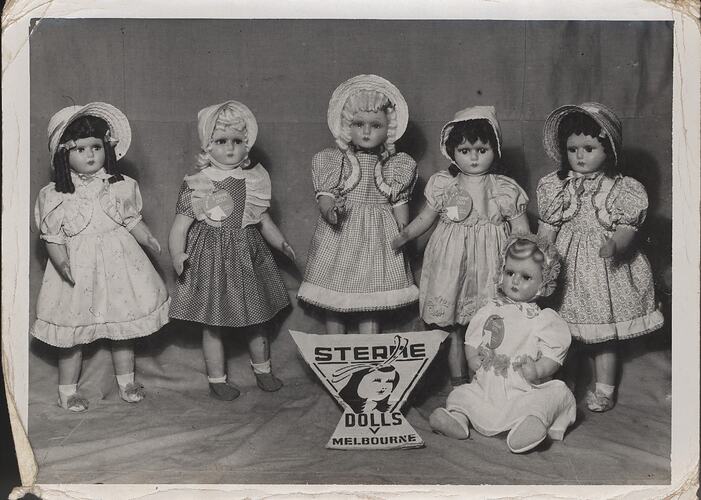Summary
Black and white photograph of Leo Sterne Company product display of six dolls, circa 1940-1973. All the dolls are standing.
Description of Content
Black & White photograph of Leo Sterne Company product display of six dolls in different frilly dresses. Five of the dolls are standing and the sixth is sitting. All dolls wear bonnets or hats. The dolls are displayed on a cotton cloth sheet/blanket. The first doll is wearing a frilly white dress with puffed sleaves, matching shoes and socks and has black hair in ringlets. The second doll is wearing a frilly white spotted dress not with puffed sleaves, matching shoes and socks and has blond hair. She has a visible product tag entitled 'Sterne doll' with a white arrow pointing upwards to her face on the tag. The third doll is wearing a frilly checked dress with puffed sleaves, shoes and socks are not visible due to a company sign. At the base of the doll which reads 'Sterne Dolls Melbourne.' The four doll is wearing a frilly plain dress with puffed sleaves, left sock is visible but not right sock or shoes. She has a visible product tag entitled 'Sterne doll' with a white arrow pointing upwards to her face on the tag. The fifth doll is wearing a frilly dress with circled patterned design possibly floral in the centre of the circular pattern only her right sock and shoe is visible. The sixth doll (the only doll seated) is wearing a white dress that is not frilly and possibly only shoes the socks are not visible. She has a visible product tag entitled 'Sterne doll' with a white arrow pointing upwards to her face on the tag.
Physical Description
Black & white photograph with a straight edge.
Significance
This item is part of a growing collection of material relating to the migration and settlement experiences of Leo and Hilda Sterne who arrived in Melbourne in 1939. They immediately established a business that became one of the most successful doll and toy manufactures in post-war Melbourne.
The L.J. Sterne Doll Company (1939-71) is significant as one of the few surviving collections related to an Australian toy and doll manufacturer, a once thriving industry in Australia. Only the A.L. Lindsay and Co. archive at the Powerhouse Museum and the Jakas Toys collection at Museum Victoria are comparable.
This collection of photographs, business and promotional documents, dolls, and toys enables the exploration of many Australian post-war historical and social themes including: local television and manufacturing industries; design and production innovation; marketing and merchandising; childhood; gender and cultural representations; leisure and sport; and key cultural and historical events.
More Information
-
Collection Names
-
Acquisition Information
Purchase
-
Place & Date Depicted
14 Hedgeley Avenue, East Malvern, Melbourne, Victoria, Australia, circa 1946-1970
-
Manufacturer of Item Depicted
14 Hedgeley Ave, East Malvern, Melbourne, Victoria, Australia, circa 1946-1970
-
Format
Photograph, Black & White
-
Inscriptions
Hand written on back, in pencil: 'B/77 6 only' and printed red ink address 'L.J. Sterne Dolls Heads Manufactures 14 Hedgeley Ave, East Malvern, Phone U.L. 2180, S.E.S, Melbourne (VIC).'
-
Classification
-
Category
-
Discipline
-
Type of item
-
Image Dimensions - Photograph
165 (Length), 120 (Width)
